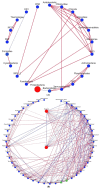Effect of Fly Maggot Protein as Dietary on Growth and Intestinal Microbial Community of Pacific White Shrimp Litopenaeus vannamei
- PMID: 37998032
- PMCID: PMC10669337
- DOI: 10.3390/biology12111433
Effect of Fly Maggot Protein as Dietary on Growth and Intestinal Microbial Community of Pacific White Shrimp Litopenaeus vannamei
Abstract
As the intensive development of aquaculture persists, the demand for fishmeal continues to grow; however, since fishery resources are limited, the price of fishmeal remains high. Therefore, there is an urgent need to develop new sources of protein. They are rich in proteins, fatty acids, amino acids, chitin, vitamins, minerals, and antibacterial substances. Maggot meal-based diet is an ideal source of high-quality animal protein and a new type of protein-based immune enhancer with good application prospects in animal husbandry and aquaculture. In the present study, we investigated the effects of three different diets containing maggot protein on the growth and intestinal microflora of Litopenaeus vannamei. The shrimp were fed either a control feed (no fly maggot protein added), FM feed (compound feed with 30% fresh fly maggot protein added), FF feed (fermented fly maggot protein), or HT feed (high-temperature pelleted fly maggot protein) for eight weeks. The results showed that fresh fly maggot protein in the feed was detrimental to shrimp growth, whereas fermented and high-temperature-pelleted fly maggot protein improved shrimp growth and survival. The effects of different fly maggot protein treatments on the intestinal microbiota of L. vannamei also varied. Fermented fly maggot protein feed and high-temperature-pelleted fly maggot protein feed increased the relative abundance of Ruegeria and Pseudomonas, which increased the abundance of beneficial bacteria and thus inhibited the growth of harmful bacteria. In contrast, fresh fly maggot proteins alter the intestinal microbiome, disrupting symbiotic relationships between bacteria, and causing invasion by Vibrio and antibiotic-resistant bacteria. These results suggest that fresh fly maggot proteins affect the composition of intestinal microorganisms, which is detrimental to the intestinal tract of L. vannamei, whereas fermented fly maggot protein feed affected the growth of L. vannamei positively by improving the composition of intestinal microorganisms.
Keywords: Litopenaeus vannamei; fly maggot protein; growth performance; intestinal microorganisms; survival rate.
Conflict of interest statement
The authors declare no conflict of interest.
Figures







Similar articles
-
Effects of dietary Clostridium autoethanogenum protein on the growth, disease resistance, intestinal digestion, immunity and microbiota structure of Litopenaeus vannamei reared at different water salinities.Front Immunol. 2022 Oct 7;13:1034994. doi: 10.3389/fimmu.2022.1034994. eCollection 2022. Front Immunol. 2022. PMID: 36275652 Free PMC article.
-
Process optimization for fermented siwu decoction by multi-index-response surface method and exploration of the effects of fermented siwu decoction on the growth, immune response and resistance to Vibrio harveyi of Pacific white shrimp (Litopenaeus vannamei).Fish Shellfish Immunol. 2022 Jan;120:633-647. doi: 10.1016/j.fsi.2021.11.029. Epub 2021 Nov 22. Fish Shellfish Immunol. 2022. PMID: 34822997
-
Dietary Use of Methionine Sources and Bacillus amyloliquefaciens CECT 5940 Influences Growth Performance, Hepatopancreatic Histology, Digestion, Immunity, and Digestive Microbiota of Litopenaeus vannamei Fed Reduced Fishmeal Diets.Animals (Basel). 2022 Dec 22;13(1):43. doi: 10.3390/ani13010043. Animals (Basel). 2022. PMID: 36611655 Free PMC article.
-
A Review: Microbes and Their Effect on Growth Performance of Litopenaeus vannamei (White Leg Shrimps) during Culture in Biofloc Technology System.Microorganisms. 2024 May 17;12(5):1013. doi: 10.3390/microorganisms12051013. Microorganisms. 2024. PMID: 38792842 Free PMC article. Review.
-
Substitution of fishmeal: Highlights of potential plant protein sources for aquaculture sustainability.Heliyon. 2024 Feb 20;10(4):e26573. doi: 10.1016/j.heliyon.2024.e26573. eCollection 2024 Feb 29. Heliyon. 2024. PMID: 38434023 Free PMC article. Review.
Cited by
-
Dielectrophoresis for Isolating Low-Abundance Bacteria Obscured by Impurities in Environmental Samples.Mar Biotechnol (NY). 2025 Mar 14;27(2):64. doi: 10.1007/s10126-025-10441-0. Mar Biotechnol (NY). 2025. PMID: 40085294 Free PMC article.
References
-
- Jobling M. National Research Council (NRC): Nutrient requirements of fish and shrimp. Aquac. Int. 2012;20:601–602. doi: 10.1007/s10499-011-9480-6. - DOI
-
- Liu C.H., Chen Z.H. Research progress on nutritional component and feeding valueof maggot protein. J. South. Agric. 2012;43:705–709.
-
- Henry M., Gasco L., Piccolo G., Fountoulaki E. Review on the use of insects in the diet of farmed fish: Past and future. Anim. Feed Sci. Technol. 2015;203:1–22. doi: 10.1016/j.anifeedsci.2015.03.001. - DOI
-
- Elahi U., Ma Y.B., Wu S.G., Wang J., Zhang H.J., Qi G.H. Growth performance, carcass characteristics, meat quality and serum profile of broiler chicks fed on housefly maggot meal as a replacement of soybean meal. J. Anim. Physiol. Anim. Nutr. 2020;104:1075–1084. doi: 10.1111/jpn.13265. - DOI - PubMed
LinkOut - more resources
Full Text Sources
Research Materials

